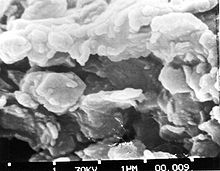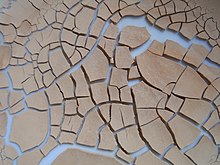Smectite
An editor has performed a search and found thatsufficient sources existto establish the subject'snotability.(May 2022) |


Asmectite(fromAncient Greekσμηκτός(smēktós)'lubricated'; fromσμηκτρίς(smēktrís)'walker's earth,fuller's earth';lit. 'rubbing earth; earth that has the property of cleaning')[1]is a mineral mixture of various swelling sheet silicates (phyllosilicates), which have a three-layer 2:1 (TOT) structure and belong to the clay minerals. Smectites mainly consist ofmontmorillonite,but can often contain secondary minerals such asquartzandcalcite.[2]
Terminology
[edit]In clay mineralogy, smectite is synonym of montmorillonite (also the name of a pure clay mineral phase) to indicate a class of swelling clays. The term smectite is commonly used in Europe and in the UK while the term montmorillonite is preferred in North America, but both terms are equivalent and can be used interchangeably. For industrial and commercial applications, the term bentonite is mostly used in place of smectite or montmorillonite.
Mineralogical structure
[edit]
The 2:1 layer (TOT) structure consists of twosilica(SiO2)tetrahedral(T) layers which are electrostatically cross-linked via an Al2O3(gibbsite), or Fe2O3,octahedral(O) central layer. The TOT elementary layers are not rigidly connected to each other but are separated by a free space: the interlayer hosting hydratedcationsandwater molecules.Smectite can swell because of the reversible incorporation of water and cations in the interlayer space.
The TOT layers are negatively charged because of the isomorphic substitution of Si(IV) atoms by Al(III) atoms in the two external silica tetrahedral layers and because of the replacement of Al(III) or Fe(III) atoms by Mg2+or Fe2+cations in the inner gibbsite octahedral layer. As the +4 charges born by Si(IV), and normally compensated by −4 charges from the surrounding oxygen atoms, become +3 due to the substitution of Si(IV) by Al(III), an electrical imbalance occurs: +3 −4 = −1. The excess of negative charges in the TOT layer has to be compensated by the presence of positive cations in the interlayer. The same reasoning also applies to the gibbsite central layer of the TOT elementary unit when an Al3+ion is replaced by a Mg2+ion in a gibbsite octahedra. The electrical imbalance is: +2 −3 = −1.
Role of interlayer cations in the swelling process
[edit]
andCa2+
ions) compensating the negative electrical charges of the TOT layers and withwater moleculescausing the interlayer expansion.
The maincationsin the smectite interlayers are Na+and Ca2+.Thesodiumcations are responsible for the highest swelling of smectite whilecalciumions have lower swelling properties. Calcium smectite has significantly less swelling capacity than sodium smectite but is also less prone to shrinking when desiccated.[3]
The degree of hydration of the cations and their corresponding hydrated radii explain the swelling or the shrinking behaviour of phyllosilicates. Other cations such as Mg2+and K+ions exhibit even a more contrasted effect: highly hydratedmagnesiumions are "swellers" as invermiculite(totally expanded interlayer) while poorly hydratedpotassiumions are "collapsers" like inillite(totally collapsed interlayer).
As the interlayer space of smectites is more open and so more easily accessible to water and cations, smectites exhibit the highestcation-exchange capacity(CEC) of clay minerals commonly found in the soils. Only more expandablevermiculiteand some rarer alumino-silicate minerals (zeolites) with inner channel structure can exhibit a higher CEC than smectite.
Formation process
[edit]
Smectites are formed from theweatheringofbasalt,gabbro,and silica-richvolcanic glass(e.g.,pumice,obsidian,rhyolite,dacite). Many smectites are formed involcanichydrothermalsystem (such asgeysersystem) where hot water percolating through theporous matrixor thecracksof thevolcanic ashdeposit (pumice,pozzolan) dissolves most ofamorphoussilica(up to 50 wt.% of SiO2can be dissolved), leaving smectite in place. This mechanism is responsible for the formation of the bentonite deposit (Serrata deNijar) ofCabo de Gatain the south-east region ofAlmeriainAndalusia(Spain). Wyoming MX-80bentonitewas formed in a similar way during theCretaceous Periodwhen volcanic ashes were falling in an inner sea on the American continent. The highlyporous(with a large and easily accessiblespecific surface) and very reactive volcanic ashes rapidly reacted withseawater.Because of silicahydrolysis,most ofsilicawas dissolved in seawater and removed from the ashes giving rise to the formation of smectites. Smectites found in many marine clay deposits are often formed in this way as it is the case for the Ypresian Clays found in Belgium and very rich in smectites.
Industrial applications
[edit]Smectites are commonly used in very diverse industrial applications. In civil engineering works, it is routinely used as a thickbentoniteslurry when excavating deep and narrow trenches in the ground to support the lateral walls and to avoid their collapse. It is also used asmudfordrilling fluids.Smectites, more commonly called bentonite, are candidate as buffer and backfill materials to fill the space around high-levelradioactive wastein deep geological repositories. Smectites also serve as additive inpaintsor asthickening agentfor various preparations.
See also
[edit]- Argillaceous minerals
- Bentonite
- Clay
- Clay chemistry
- Clay mineral
- Clay–water interaction
- Expansive clay
- Hectorite
- Montmorillonite
- Nontronite
- Saponite
References
[edit]- ^CNRLT (2012)."Smectite: Définition de smectite"[Smectite: Definition of smectite].cnrtl.fr(in French).Retrieved28 July2022.
Terre qui a la propriété de nettoyer. Earth that has the property of cleaning
- ^ Friedrich Klockmann(1978) [1891],Paul Ramdohr,Hugo Strunz(ed.),Klockmanns Lehrbuch der Mineralogie(in German) (16. ed.), Stuttgart: Enke, p. 753,ISBN3-432-82986-8
- ^Barast, Gilles; Razakamanantsoa, Andry-Rico; Djeran-Maigre, Irini; Nicholson, Timothy; Williams, David (June 2017). "Swelling properties of natural and modified bentonites by rheological description".Applied Clay Science.142:60–68.Bibcode:2017ApCS..142...60B.doi:10.1016/j.clay.2016.01.008.
Further reading
[edit]- Meunier, Alain (2005).Clays.Springer Science & Business Media. pp. 108–.ISBN978-3-540-21667-4.
- Mitchell, J. K. (2001). Physicochemistry of soils for geoenvironmental engineering. In Geotechnical and geoenvironmental engineering handbook (pp. 691-710). Springer, Boston, MA.
- Mitchell, J. K., & Soga, K. (2005). Fundamentals of soil behavior (Vol. 3). New York: John Wiley & Sons.
- Mackenzie, R. C., & Mitchell, B. D. (1966). Clay mineralogy. Earth-Science Reviews, 2, 47–91.
- Jeans, C. V., Merriman, R. J., Mitchell, J. G., & Bland, D. J. (1982). Volcanic clays in the Cretaceous of southern England and Northern Ireland. Clay Minerals, 17(1), 105–156.https://doi.org/10.1180/claymin.1982.017.1.10
- Wagner, J. F. (2013). Chapter 9: Mechanical properties of clays and clay minerals. In: Developments in Clay Science, 5, 347–381. Elsevier.https://doi.org/10.1016/B978-0-08-098258-8.00011-0
